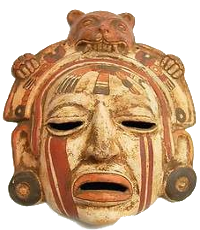Aztlán and the Chicano movement
Aztlán is, according to the legend of Nahuatl-speaking peoples, the land from which they, some time in the eleventh-century CE, began the migration which eventually took them to the Valley of Mexico. There were seven different tribes that migrated, of which the Mexica was one. It is clear that Aztlán was located somewhere to the north but exactly where is less certain. Guesses point to northwestern Mexico or to somewhere in the southwestern parts of the United States.
References to Aztlán have been important among members of the Chicano movement in the United States. “Chicano” is the name given to Mexicans who have emigrated to the US, originally as seasonal labor in the agricultural industry. In response to mistreatment by employers and US authorities, they began organizing themselves politically in the 1960s. According to some Chicano activists, Europeans are aggressors who have invaded land which originally belonged to them and to which they have a right of return.
Prior to 1848, southwestern United States was a part of Mexico. In 1835, Texas declared itself an independent republic, something which the Mexican government refused to accept. When Texas was annexed by the United States in 1845, Mexico went to war. Yet the Mexican government was weak, its troops badly equipped and trained, and they were easily defeated by the Americans. As a result, Mexico lost about half of its territory – corresponding to the present-day states of California, Nevada, and Utah, most of New Mexico, Arizona and Colorado, and parts of Texas, Oklahoma, Kansas and Wyoming.
There are activists who hope for a new, independent, Aztlán. In one version of the project, Mexicans on both side of the border should create one country, sometimes referred to as “la República del Norte.” Others have talked about the need for a “reconquista” of the parts of the United States which were parts of Mexico until the Mexican-American war. The Chicano movement lost much of its political momentum in the 1970s, but the problems they reacted to have not gone away. Their most lasting legacy might be the departments of “Chicano studies” that have been established at various American universities. If a wall is built between the United States and Mexico, it would be regarded as a provocation by Aztlán activists.
External links:
- Alurista, El Plan Espiritual de Aztlán, 1969
- Chicano Newspapers and Periodicals 1966-1979
- Dr. Charles Truxillo: Chicano Nationalist and Intellectual
- Edward Escobar, “The Dialectics of Repression: The Los Angeles Police Department and the Chicano Movement, 1968–1971”
- Library of Congress, “Guide to the Mexican War”
- Mexican American News
- The Struggle for Chicano Liberation
- U of California, Santa Barbara, Dept of Chican@ Studies
- UCLA, Dept of Chicana/o Studies

